BSBRSK501 Manage Risk: Comprehensive Solutions to Workbook Tasks
VerifiedAdded on 2023/06/11
|40
|6208
|276
Homework Assignment
AI Summary
This document provides detailed solutions to the BSBRSK501 Manage Risk Learner Workbook activities. It covers various aspects of risk management, including understanding organizational processes, determining the scope of risk management, identifying internal and external stakeholders, and reviewing political, economic, social, legal, technological, and policy contexts. The solutions address activities related to risk identification, analysis, and treatment, offering insights into legal frameworks, stakeholder objectives, and potential impacts of risk events. Case studies are included to illustrate practical applications of risk management principles and problem-solving strategies. The document also contains declaration and competency record for assessment purposes.
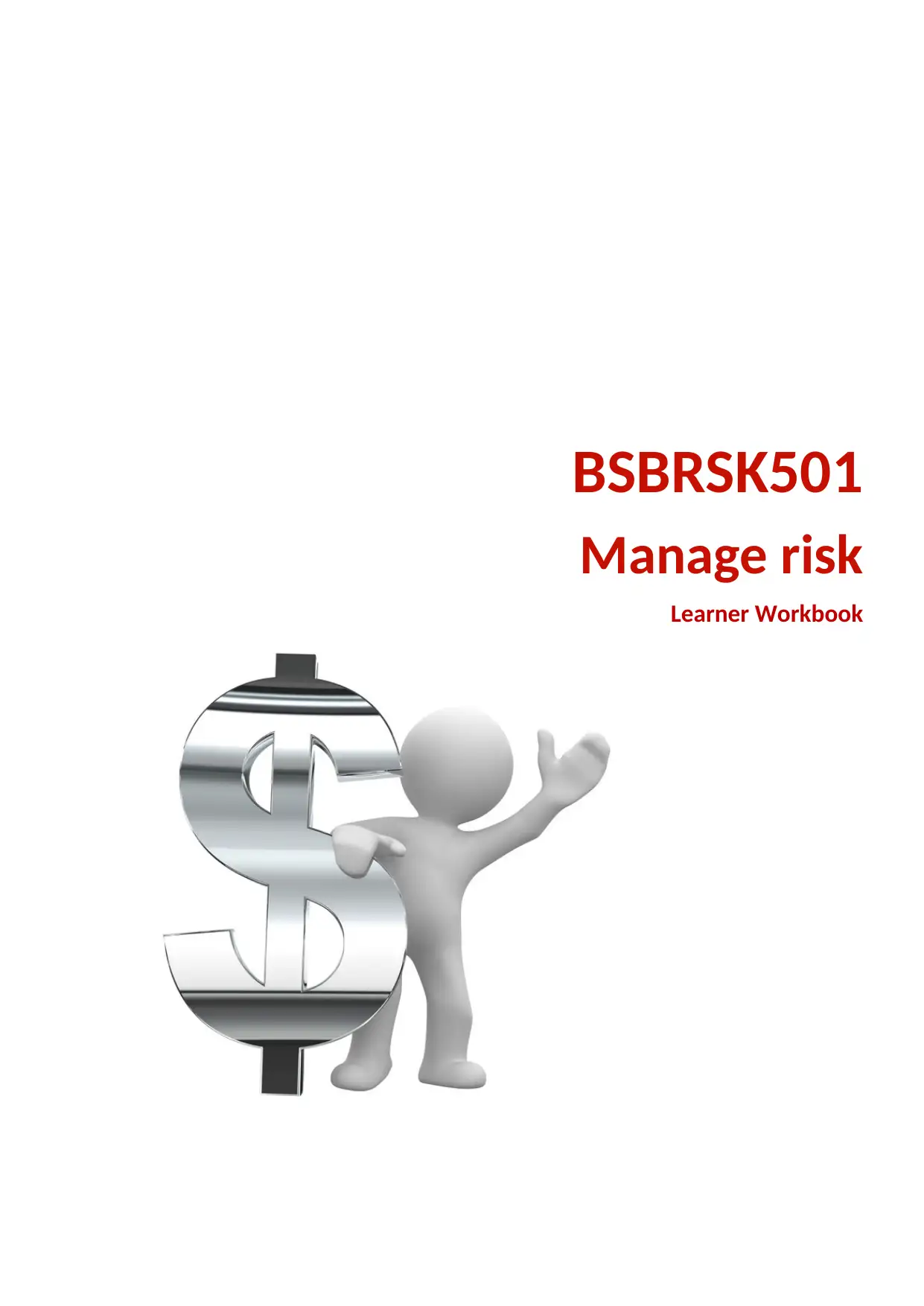
BSBRSK501
Manage risk
Learner Workbook
Manage risk
Learner Workbook
Paraphrase This Document
Need a fresh take? Get an instant paraphrase of this document with our AI Paraphraser
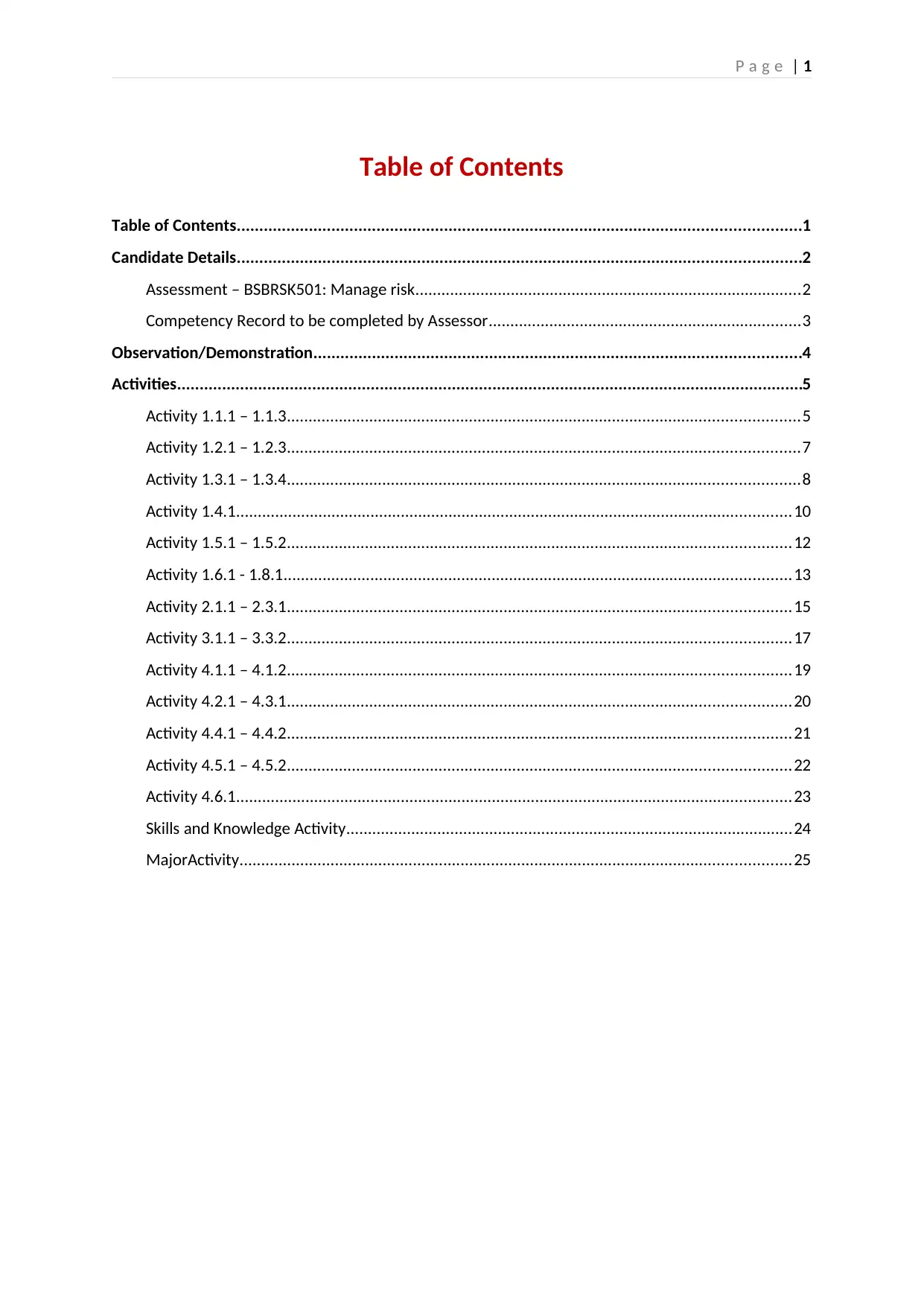
P a g e | 1
Table of Contents
Table of Contents.............................................................................................................................1
Candidate Details.............................................................................................................................2
Assessment – BSBRSK501: Manage risk.........................................................................................2
Competency Record to be completed by Assessor........................................................................3
Observation/Demonstration............................................................................................................4
Activities...........................................................................................................................................5
Activity 1.1.1 – 1.1.3......................................................................................................................5
Activity 1.2.1 – 1.2.3......................................................................................................................7
Activity 1.3.1 – 1.3.4......................................................................................................................8
Activity 1.4.1................................................................................................................................10
Activity 1.5.1 – 1.5.2....................................................................................................................12
Activity 1.6.1 - 1.8.1.....................................................................................................................13
Activity 2.1.1 – 2.3.1....................................................................................................................15
Activity 3.1.1 – 3.3.2....................................................................................................................17
Activity 4.1.1 – 4.1.2....................................................................................................................19
Activity 4.2.1 – 4.3.1....................................................................................................................20
Activity 4.4.1 – 4.4.2....................................................................................................................21
Activity 4.5.1 – 4.5.2....................................................................................................................22
Activity 4.6.1................................................................................................................................23
Skills and Knowledge Activity.......................................................................................................24
MajorActivity...............................................................................................................................25
Table of Contents
Table of Contents.............................................................................................................................1
Candidate Details.............................................................................................................................2
Assessment – BSBRSK501: Manage risk.........................................................................................2
Competency Record to be completed by Assessor........................................................................3
Observation/Demonstration............................................................................................................4
Activities...........................................................................................................................................5
Activity 1.1.1 – 1.1.3......................................................................................................................5
Activity 1.2.1 – 1.2.3......................................................................................................................7
Activity 1.3.1 – 1.3.4......................................................................................................................8
Activity 1.4.1................................................................................................................................10
Activity 1.5.1 – 1.5.2....................................................................................................................12
Activity 1.6.1 - 1.8.1.....................................................................................................................13
Activity 2.1.1 – 2.3.1....................................................................................................................15
Activity 3.1.1 – 3.3.2....................................................................................................................17
Activity 4.1.1 – 4.1.2....................................................................................................................19
Activity 4.2.1 – 4.3.1....................................................................................................................20
Activity 4.4.1 – 4.4.2....................................................................................................................21
Activity 4.5.1 – 4.5.2....................................................................................................................22
Activity 4.6.1................................................................................................................................23
Skills and Knowledge Activity.......................................................................................................24
MajorActivity...............................................................................................................................25
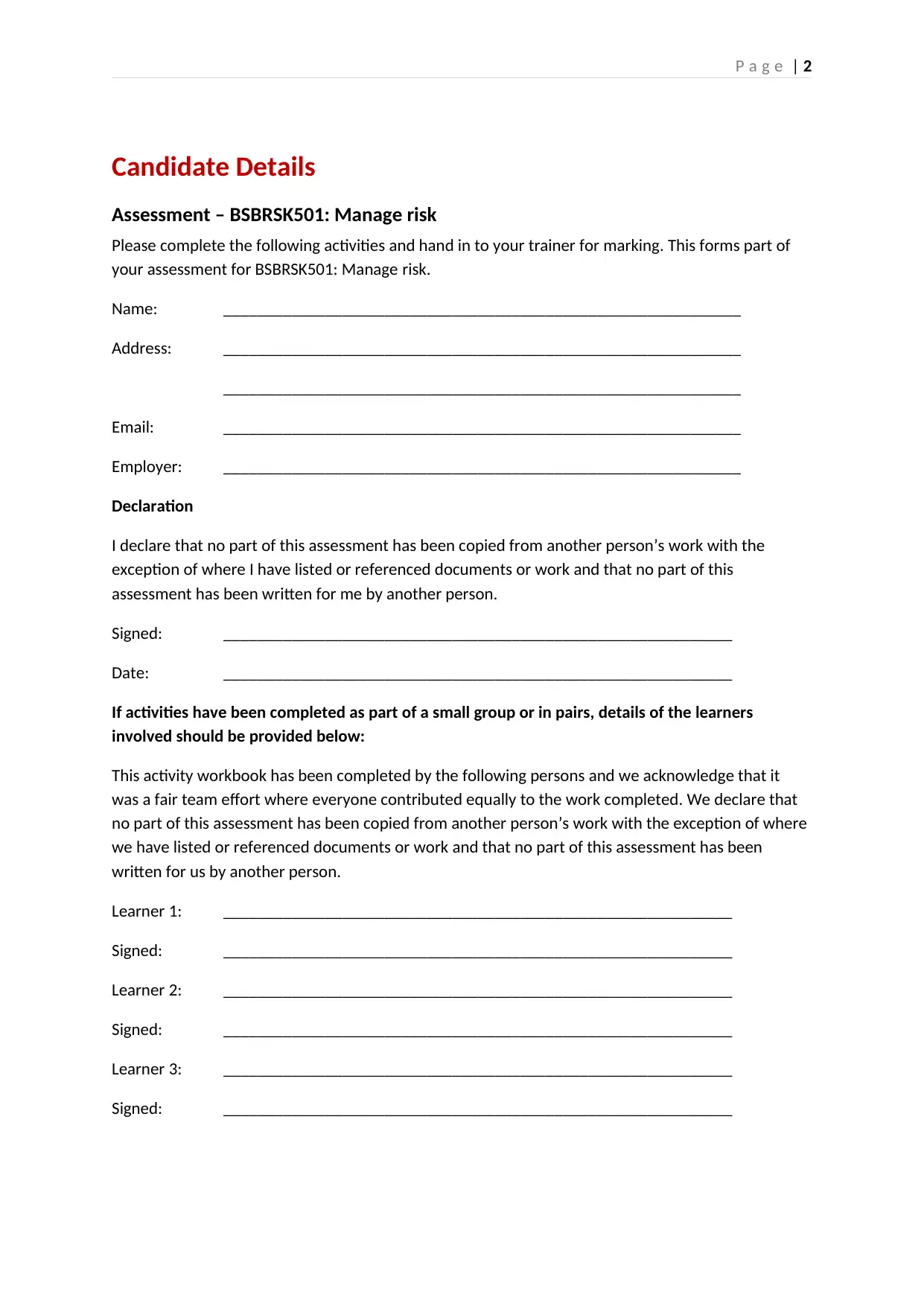
P a g e | 2
Candidate Details
Assessment – BSBRSK501: Manage risk
Please complete the following activities and hand in to your trainer for marking. This forms part of
your assessment for BSBRSK501: Manage risk.
Name: _____________________________________________________________
Address: _____________________________________________________________
_____________________________________________________________
Email: _____________________________________________________________
Employer: _____________________________________________________________
Declaration
I declare that no part of this assessment has been copied from another person’s work with the
exception of where I have listed or referenced documents or work and that no part of this
assessment has been written for me by another person.
Signed: ____________________________________________________________
Date: ____________________________________________________________
If activities have been completed as part of a small group or in pairs, details of the learners
involved should be provided below:
This activity workbook has been completed by the following persons and we acknowledge that it
was a fair team effort where everyone contributed equally to the work completed. We declare that
no part of this assessment has been copied from another person’s work with the exception of where
we have listed or referenced documents or work and that no part of this assessment has been
written for us by another person.
Learner 1: ____________________________________________________________
Signed: ____________________________________________________________
Learner 2: ____________________________________________________________
Signed: ____________________________________________________________
Learner 3: ____________________________________________________________
Signed: ____________________________________________________________
Candidate Details
Assessment – BSBRSK501: Manage risk
Please complete the following activities and hand in to your trainer for marking. This forms part of
your assessment for BSBRSK501: Manage risk.
Name: _____________________________________________________________
Address: _____________________________________________________________
_____________________________________________________________
Email: _____________________________________________________________
Employer: _____________________________________________________________
Declaration
I declare that no part of this assessment has been copied from another person’s work with the
exception of where I have listed or referenced documents or work and that no part of this
assessment has been written for me by another person.
Signed: ____________________________________________________________
Date: ____________________________________________________________
If activities have been completed as part of a small group or in pairs, details of the learners
involved should be provided below:
This activity workbook has been completed by the following persons and we acknowledge that it
was a fair team effort where everyone contributed equally to the work completed. We declare that
no part of this assessment has been copied from another person’s work with the exception of where
we have listed or referenced documents or work and that no part of this assessment has been
written for us by another person.
Learner 1: ____________________________________________________________
Signed: ____________________________________________________________
Learner 2: ____________________________________________________________
Signed: ____________________________________________________________
Learner 3: ____________________________________________________________
Signed: ____________________________________________________________
⊘ This is a preview!⊘
Do you want full access?
Subscribe today to unlock all pages.

Trusted by 1+ million students worldwide
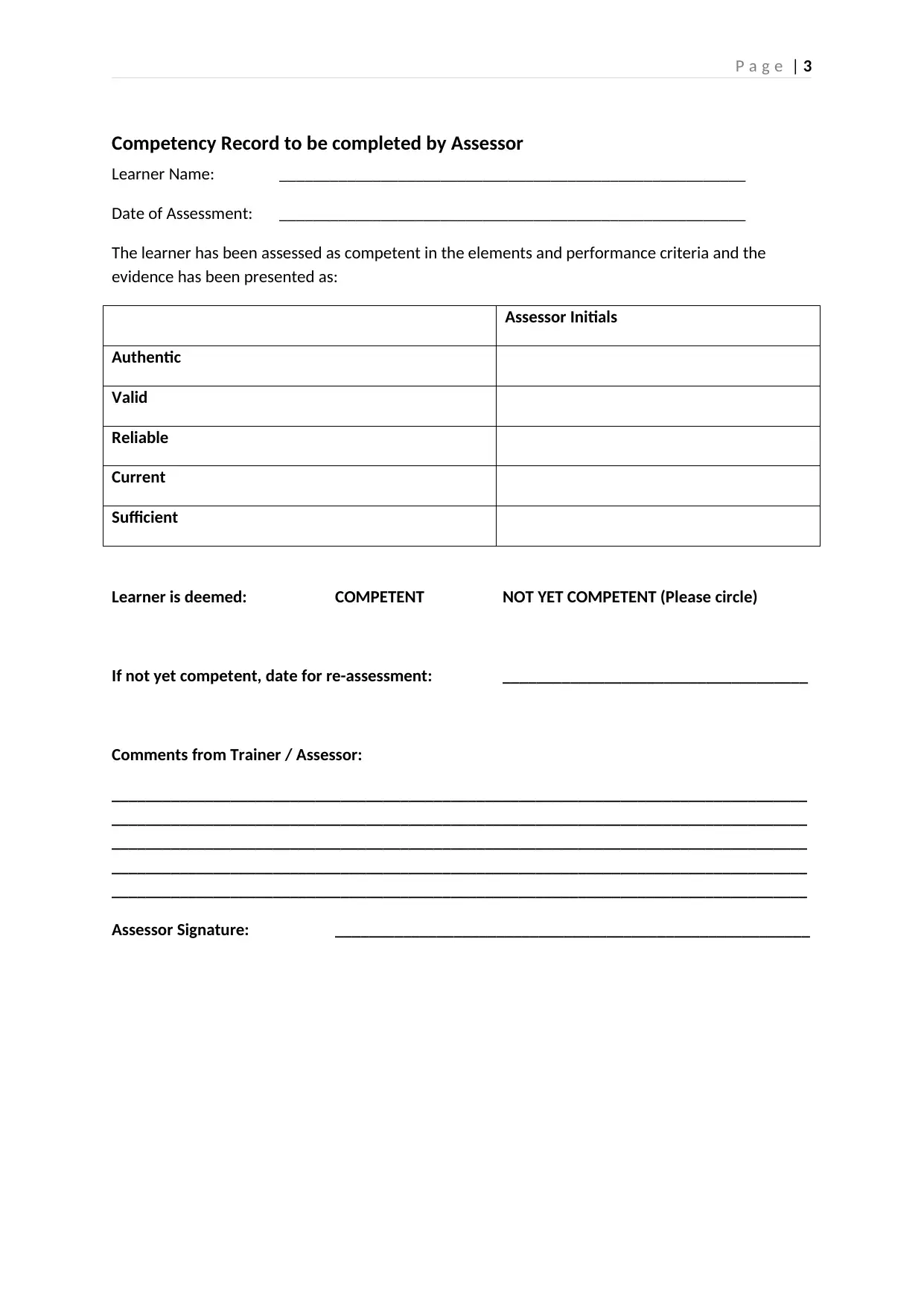
P a g e | 3
Competency Record to be completed by Assessor
Learner Name: _______________________________________________________
Date of Assessment: _______________________________________________________
The learner has been assessed as competent in the elements and performance criteria and the
evidence has been presented as:
Assessor Initials
Authentic
Valid
Reliable
Current
Sufficient
Learner is deemed: COMPETENT NOT YET COMPETENT (Please circle)
If not yet competent, date for re-assessment: ____________________________________
Comments from Trainer / Assessor:
__________________________________________________________________________________
__________________________________________________________________________________
__________________________________________________________________________________
__________________________________________________________________________________
__________________________________________________________________________________
Assessor Signature: ________________________________________________________
Competency Record to be completed by Assessor
Learner Name: _______________________________________________________
Date of Assessment: _______________________________________________________
The learner has been assessed as competent in the elements and performance criteria and the
evidence has been presented as:
Assessor Initials
Authentic
Valid
Reliable
Current
Sufficient
Learner is deemed: COMPETENT NOT YET COMPETENT (Please circle)
If not yet competent, date for re-assessment: ____________________________________
Comments from Trainer / Assessor:
__________________________________________________________________________________
__________________________________________________________________________________
__________________________________________________________________________________
__________________________________________________________________________________
__________________________________________________________________________________
Assessor Signature: ________________________________________________________
Paraphrase This Document
Need a fresh take? Get an instant paraphrase of this document with our AI Paraphraser
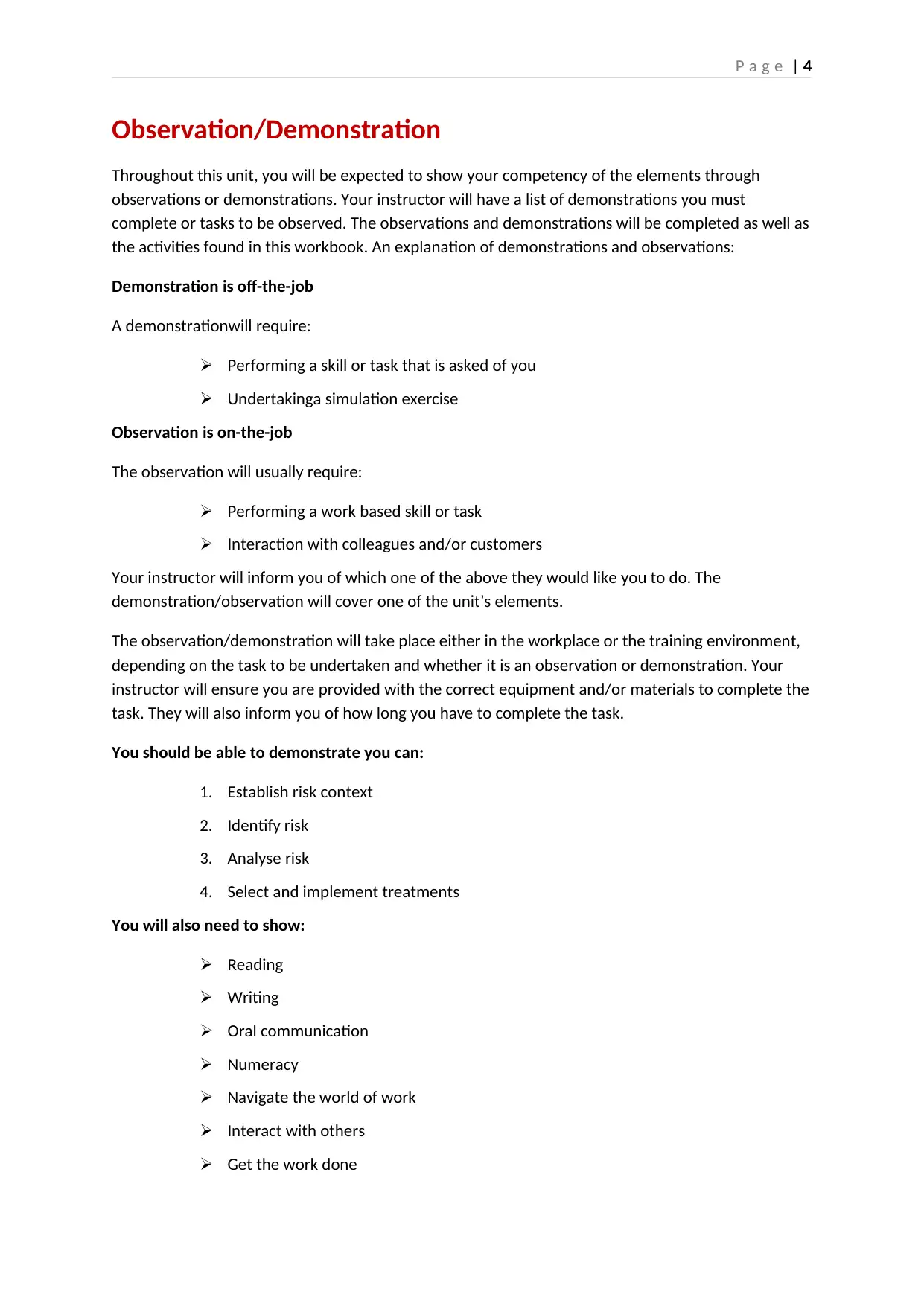
P a g e | 4
Observation/Demonstration
Throughout this unit, you will be expected to show your competency of the elements through
observations or demonstrations. Your instructor will have a list of demonstrations you must
complete or tasks to be observed. The observations and demonstrations will be completed as well as
the activities found in this workbook. An explanation of demonstrations and observations:
Demonstration is off-the-job
A demonstrationwill require:
Performing a skill or task that is asked of you
Undertakinga simulation exercise
Observation is on-the-job
The observation will usually require:
Performing a work based skill or task
Interaction with colleagues and/or customers
Your instructor will inform you of which one of the above they would like you to do. The
demonstration/observation will cover one of the unit’s elements.
The observation/demonstration will take place either in the workplace or the training environment,
depending on the task to be undertaken and whether it is an observation or demonstration. Your
instructor will ensure you are provided with the correct equipment and/or materials to complete the
task. They will also inform you of how long you have to complete the task.
You should be able to demonstrate you can:
1. Establish risk context
2. Identify risk
3. Analyse risk
4. Select and implement treatments
You will also need to show:
Reading
Writing
Oral communication
Numeracy
Navigate the world of work
Interact with others
Get the work done
Observation/Demonstration
Throughout this unit, you will be expected to show your competency of the elements through
observations or demonstrations. Your instructor will have a list of demonstrations you must
complete or tasks to be observed. The observations and demonstrations will be completed as well as
the activities found in this workbook. An explanation of demonstrations and observations:
Demonstration is off-the-job
A demonstrationwill require:
Performing a skill or task that is asked of you
Undertakinga simulation exercise
Observation is on-the-job
The observation will usually require:
Performing a work based skill or task
Interaction with colleagues and/or customers
Your instructor will inform you of which one of the above they would like you to do. The
demonstration/observation will cover one of the unit’s elements.
The observation/demonstration will take place either in the workplace or the training environment,
depending on the task to be undertaken and whether it is an observation or demonstration. Your
instructor will ensure you are provided with the correct equipment and/or materials to complete the
task. They will also inform you of how long you have to complete the task.
You should be able to demonstrate you can:
1. Establish risk context
2. Identify risk
3. Analyse risk
4. Select and implement treatments
You will also need to show:
Reading
Writing
Oral communication
Numeracy
Navigate the world of work
Interact with others
Get the work done
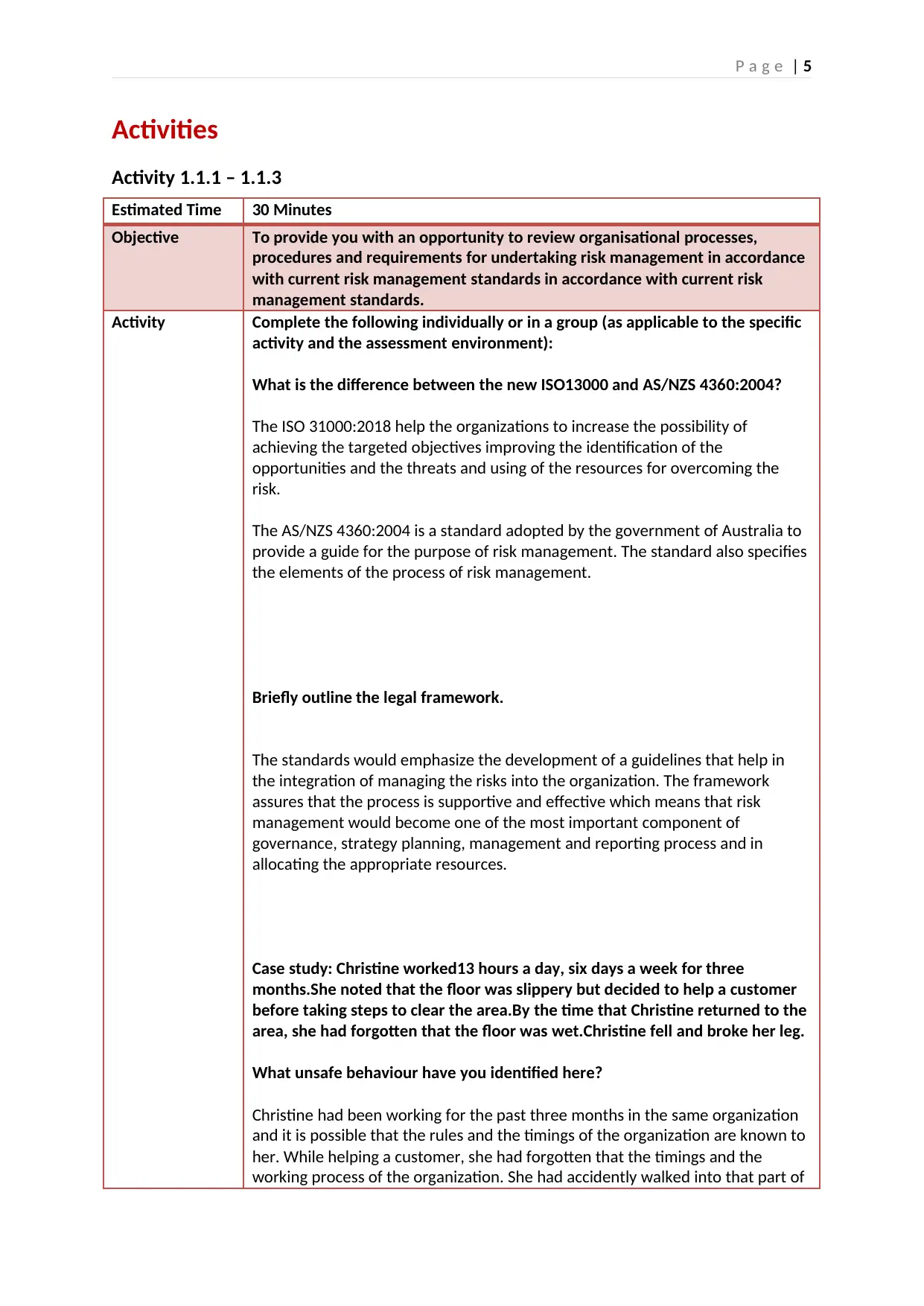
P a g e | 5
Activities
Activity 1.1.1 – 1.1.3
Estimated Time 30 Minutes
Objective To provide you with an opportunity to review organisational processes,
procedures and requirements for undertaking risk management in accordance
with current risk management standards in accordance with current risk
management standards.
Activity Complete the following individually or in a group (as applicable to the specific
activity and the assessment environment):
What is the difference between the new ISO13000 and AS/NZS 4360:2004?
The ISO 31000:2018 help the organizations to increase the possibility of
achieving the targeted objectives improving the identification of the
opportunities and the threats and using of the resources for overcoming the
risk.
The AS/NZS 4360:2004 is a standard adopted by the government of Australia to
provide a guide for the purpose of risk management. The standard also specifies
the elements of the process of risk management.
Briefly outline the legal framework.
The standards would emphasize the development of a guidelines that help in
the integration of managing the risks into the organization. The framework
assures that the process is supportive and effective which means that risk
management would become one of the most important component of
governance, strategy planning, management and reporting process and in
allocating the appropriate resources.
Case study: Christine worked13 hours a day, six days a week for three
months.She noted that the floor was slippery but decided to help a customer
before taking steps to clear the area.By the time that Christine returned to the
area, she had forgotten that the floor was wet.Christine fell and broke her leg.
What unsafe behaviour have you identified here?
Christine had been working for the past three months in the same organization
and it is possible that the rules and the timings of the organization are known to
her. While helping a customer, she had forgotten that the timings and the
working process of the organization. She had accidently walked into that part of
Activities
Activity 1.1.1 – 1.1.3
Estimated Time 30 Minutes
Objective To provide you with an opportunity to review organisational processes,
procedures and requirements for undertaking risk management in accordance
with current risk management standards in accordance with current risk
management standards.
Activity Complete the following individually or in a group (as applicable to the specific
activity and the assessment environment):
What is the difference between the new ISO13000 and AS/NZS 4360:2004?
The ISO 31000:2018 help the organizations to increase the possibility of
achieving the targeted objectives improving the identification of the
opportunities and the threats and using of the resources for overcoming the
risk.
The AS/NZS 4360:2004 is a standard adopted by the government of Australia to
provide a guide for the purpose of risk management. The standard also specifies
the elements of the process of risk management.
Briefly outline the legal framework.
The standards would emphasize the development of a guidelines that help in
the integration of managing the risks into the organization. The framework
assures that the process is supportive and effective which means that risk
management would become one of the most important component of
governance, strategy planning, management and reporting process and in
allocating the appropriate resources.
Case study: Christine worked13 hours a day, six days a week for three
months.She noted that the floor was slippery but decided to help a customer
before taking steps to clear the area.By the time that Christine returned to the
area, she had forgotten that the floor was wet.Christine fell and broke her leg.
What unsafe behaviour have you identified here?
Christine had been working for the past three months in the same organization
and it is possible that the rules and the timings of the organization are known to
her. While helping a customer, she had forgotten that the timings and the
working process of the organization. She had accidently walked into that part of
⊘ This is a preview!⊘
Do you want full access?
Subscribe today to unlock all pages.

Trusted by 1+ million students worldwide
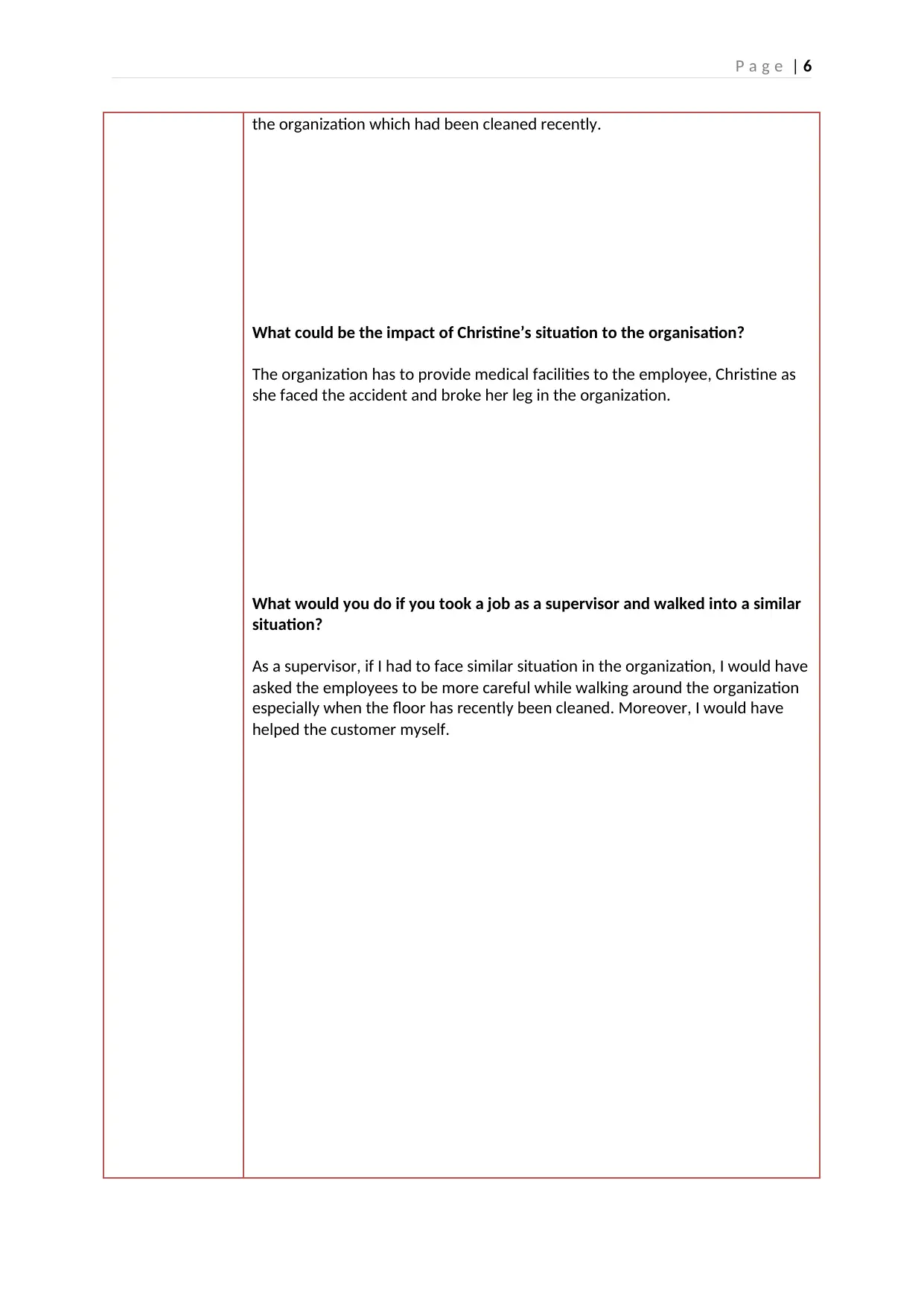
P a g e | 6
the organization which had been cleaned recently.
What could be the impact of Christine’s situation to the organisation?
The organization has to provide medical facilities to the employee, Christine as
she faced the accident and broke her leg in the organization.
What would you do if you took a job as a supervisor and walked into a similar
situation?
As a supervisor, if I had to face similar situation in the organization, I would have
asked the employees to be more careful while walking around the organization
especially when the floor has recently been cleaned. Moreover, I would have
helped the customer myself.
the organization which had been cleaned recently.
What could be the impact of Christine’s situation to the organisation?
The organization has to provide medical facilities to the employee, Christine as
she faced the accident and broke her leg in the organization.
What would you do if you took a job as a supervisor and walked into a similar
situation?
As a supervisor, if I had to face similar situation in the organization, I would have
asked the employees to be more careful while walking around the organization
especially when the floor has recently been cleaned. Moreover, I would have
helped the customer myself.
Paraphrase This Document
Need a fresh take? Get an instant paraphrase of this document with our AI Paraphraser

P a g e | 7
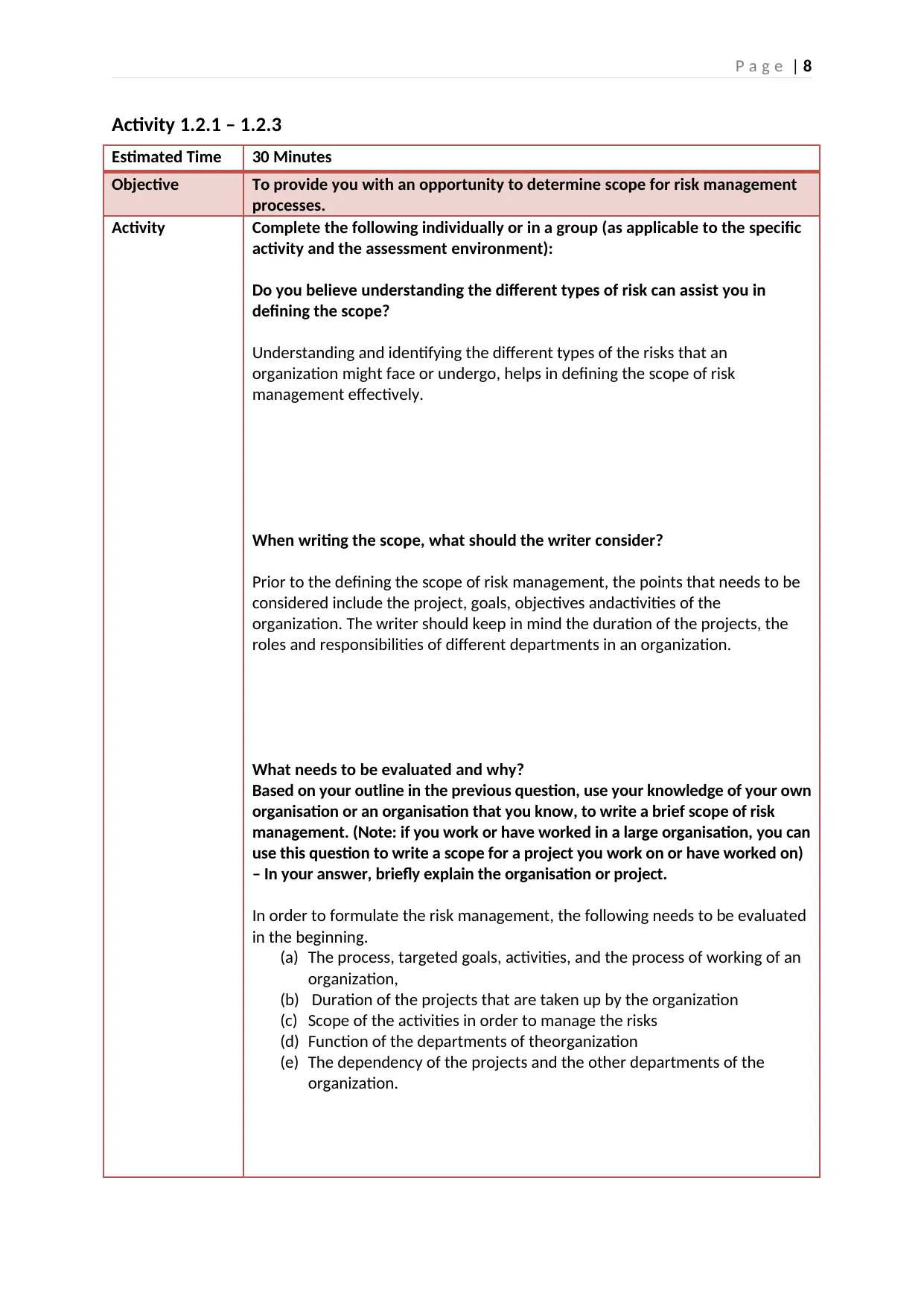
P a g e | 8
Activity 1.2.1 – 1.2.3
Estimated Time 30 Minutes
Objective To provide you with an opportunity to determine scope for risk management
processes.
Activity Complete the following individually or in a group (as applicable to the specific
activity and the assessment environment):
Do you believe understanding the different types of risk can assist you in
defining the scope?
Understanding and identifying the different types of the risks that an
organization might face or undergo, helps in defining the scope of risk
management effectively.
When writing the scope, what should the writer consider?
Prior to the defining the scope of risk management, the points that needs to be
considered include the project, goals, objectives andactivities of the
organization. The writer should keep in mind the duration of the projects, the
roles and responsibilities of different departments in an organization.
What needs to be evaluated and why?
Based on your outline in the previous question, use your knowledge of your own
organisation or an organisation that you know, to write a brief scope of risk
management. (Note: if you work or have worked in a large organisation, you can
use this question to write a scope for a project you work on or have worked on)
– In your answer, briefly explain the organisation or project.
In order to formulate the risk management, the following needs to be evaluated
in the beginning.
(a) The process, targeted goals, activities, and the process of working of an
organization,
(b) Duration of the projects that are taken up by the organization
(c) Scope of the activities in order to manage the risks
(d) Function of the departments of theorganization
(e) The dependency of the projects and the other departments of the
organization.
Activity 1.2.1 – 1.2.3
Estimated Time 30 Minutes
Objective To provide you with an opportunity to determine scope for risk management
processes.
Activity Complete the following individually or in a group (as applicable to the specific
activity and the assessment environment):
Do you believe understanding the different types of risk can assist you in
defining the scope?
Understanding and identifying the different types of the risks that an
organization might face or undergo, helps in defining the scope of risk
management effectively.
When writing the scope, what should the writer consider?
Prior to the defining the scope of risk management, the points that needs to be
considered include the project, goals, objectives andactivities of the
organization. The writer should keep in mind the duration of the projects, the
roles and responsibilities of different departments in an organization.
What needs to be evaluated and why?
Based on your outline in the previous question, use your knowledge of your own
organisation or an organisation that you know, to write a brief scope of risk
management. (Note: if you work or have worked in a large organisation, you can
use this question to write a scope for a project you work on or have worked on)
– In your answer, briefly explain the organisation or project.
In order to formulate the risk management, the following needs to be evaluated
in the beginning.
(a) The process, targeted goals, activities, and the process of working of an
organization,
(b) Duration of the projects that are taken up by the organization
(c) Scope of the activities in order to manage the risks
(d) Function of the departments of theorganization
(e) The dependency of the projects and the other departments of the
organization.
⊘ This is a preview!⊘
Do you want full access?
Subscribe today to unlock all pages.

Trusted by 1+ million students worldwide

P a g e | 9
Paraphrase This Document
Need a fresh take? Get an instant paraphrase of this document with our AI Paraphraser
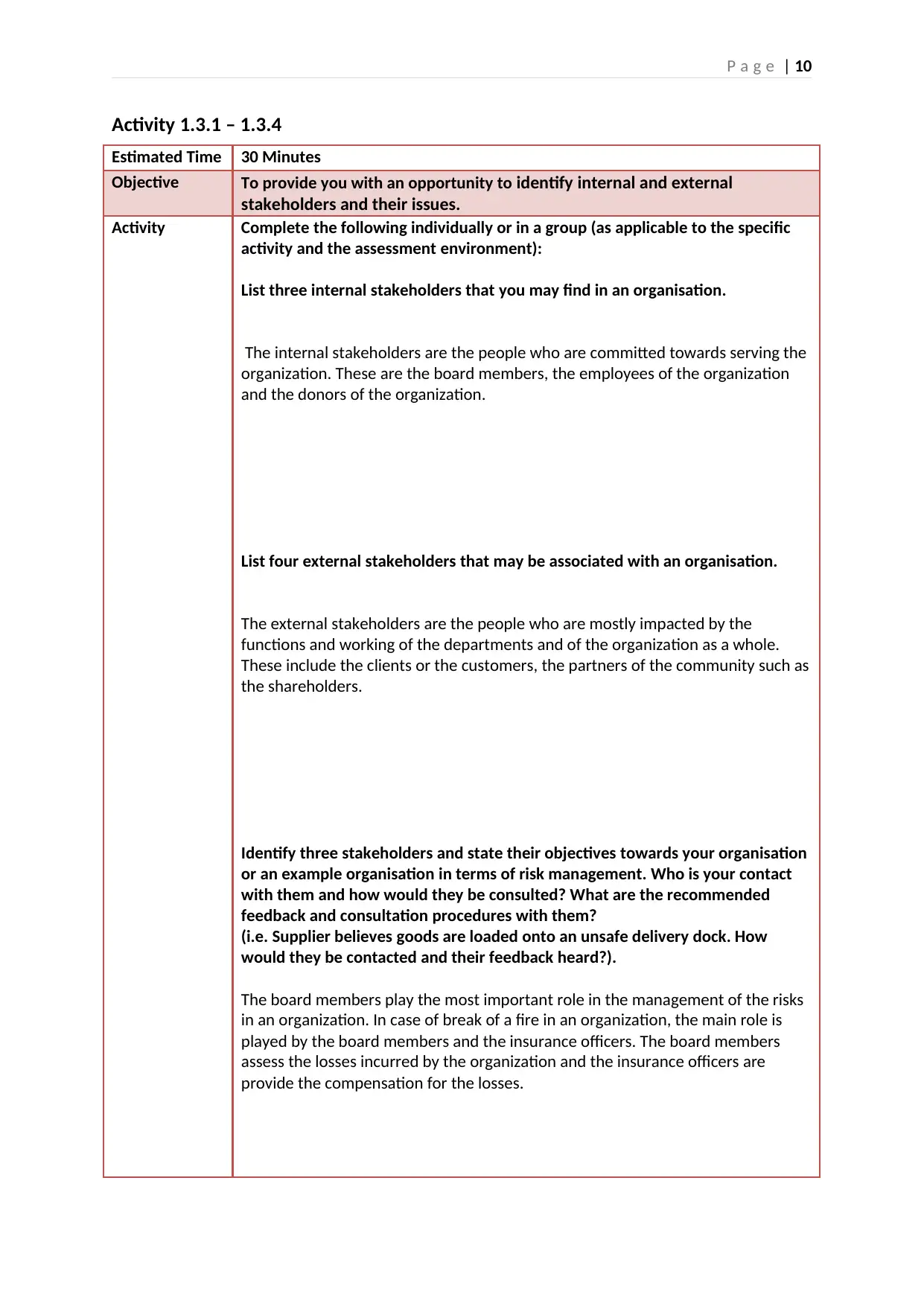
P a g e | 10
Activity 1.3.1 – 1.3.4
Estimated Time 30 Minutes
Objective To provide you with an opportunity to identify internal and external
stakeholders and their issues.
Activity Complete the following individually or in a group (as applicable to the specific
activity and the assessment environment):
List three internal stakeholders that you may find in an organisation.
The internal stakeholders are the people who are committed towards serving the
organization. These are the board members, the employees of the organization
and the donors of the organization.
List four external stakeholders that may be associated with an organisation.
The external stakeholders are the people who are mostly impacted by the
functions and working of the departments and of the organization as a whole.
These include the clients or the customers, the partners of the community such as
the shareholders.
Identify three stakeholders and state their objectives towards your organisation
or an example organisation in terms of risk management. Who is your contact
with them and how would they be consulted? What are the recommended
feedback and consultation procedures with them?
(i.e. Supplier believes goods are loaded onto an unsafe delivery dock. How
would they be contacted and their feedback heard?).
The board members play the most important role in the management of the risks
in an organization. In case of break of a fire in an organization, the main role is
played by the board members and the insurance officers. The board members
assess the losses incurred by the organization and the insurance officers are
provide the compensation for the losses.
Activity 1.3.1 – 1.3.4
Estimated Time 30 Minutes
Objective To provide you with an opportunity to identify internal and external
stakeholders and their issues.
Activity Complete the following individually or in a group (as applicable to the specific
activity and the assessment environment):
List three internal stakeholders that you may find in an organisation.
The internal stakeholders are the people who are committed towards serving the
organization. These are the board members, the employees of the organization
and the donors of the organization.
List four external stakeholders that may be associated with an organisation.
The external stakeholders are the people who are mostly impacted by the
functions and working of the departments and of the organization as a whole.
These include the clients or the customers, the partners of the community such as
the shareholders.
Identify three stakeholders and state their objectives towards your organisation
or an example organisation in terms of risk management. Who is your contact
with them and how would they be consulted? What are the recommended
feedback and consultation procedures with them?
(i.e. Supplier believes goods are loaded onto an unsafe delivery dock. How
would they be contacted and their feedback heard?).
The board members play the most important role in the management of the risks
in an organization. In case of break of a fire in an organization, the main role is
played by the board members and the insurance officers. The board members
assess the losses incurred by the organization and the insurance officers are
provide the compensation for the losses.
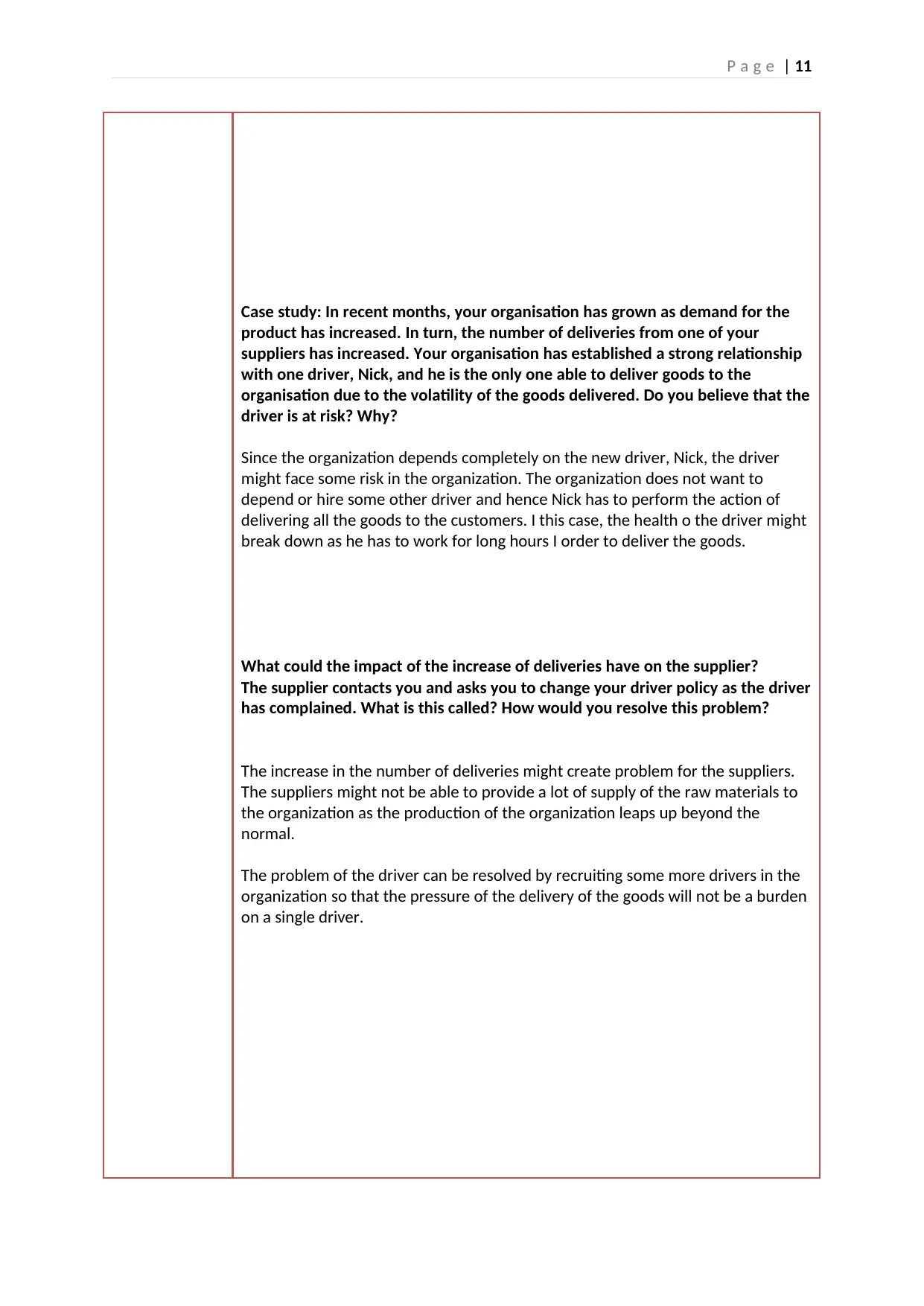
P a g e | 11
Case study: In recent months, your organisation has grown as demand for the
product has increased. In turn, the number of deliveries from one of your
suppliers has increased. Your organisation has established a strong relationship
with one driver, Nick, and he is the only one able to deliver goods to the
organisation due to the volatility of the goods delivered. Do you believe that the
driver is at risk? Why?
Since the organization depends completely on the new driver, Nick, the driver
might face some risk in the organization. The organization does not want to
depend or hire some other driver and hence Nick has to perform the action of
delivering all the goods to the customers. I this case, the health o the driver might
break down as he has to work for long hours I order to deliver the goods.
What could the impact of the increase of deliveries have on the supplier?
The supplier contacts you and asks you to change your driver policy as the driver
has complained. What is this called? How would you resolve this problem?
The increase in the number of deliveries might create problem for the suppliers.
The suppliers might not be able to provide a lot of supply of the raw materials to
the organization as the production of the organization leaps up beyond the
normal.
The problem of the driver can be resolved by recruiting some more drivers in the
organization so that the pressure of the delivery of the goods will not be a burden
on a single driver.
Case study: In recent months, your organisation has grown as demand for the
product has increased. In turn, the number of deliveries from one of your
suppliers has increased. Your organisation has established a strong relationship
with one driver, Nick, and he is the only one able to deliver goods to the
organisation due to the volatility of the goods delivered. Do you believe that the
driver is at risk? Why?
Since the organization depends completely on the new driver, Nick, the driver
might face some risk in the organization. The organization does not want to
depend or hire some other driver and hence Nick has to perform the action of
delivering all the goods to the customers. I this case, the health o the driver might
break down as he has to work for long hours I order to deliver the goods.
What could the impact of the increase of deliveries have on the supplier?
The supplier contacts you and asks you to change your driver policy as the driver
has complained. What is this called? How would you resolve this problem?
The increase in the number of deliveries might create problem for the suppliers.
The suppliers might not be able to provide a lot of supply of the raw materials to
the organization as the production of the organization leaps up beyond the
normal.
The problem of the driver can be resolved by recruiting some more drivers in the
organization so that the pressure of the delivery of the goods will not be a burden
on a single driver.
⊘ This is a preview!⊘
Do you want full access?
Subscribe today to unlock all pages.

Trusted by 1+ million students worldwide
1 out of 40
Related Documents
Your All-in-One AI-Powered Toolkit for Academic Success.
+13062052269
info@desklib.com
Available 24*7 on WhatsApp / Email
![[object Object]](/_next/static/media/star-bottom.7253800d.svg)
Unlock your academic potential
Copyright © 2020–2025 A2Z Services. All Rights Reserved. Developed and managed by ZUCOL.




